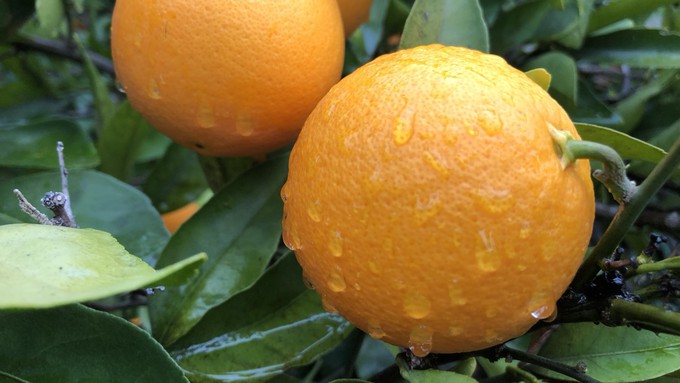
New Year starts like the old year ends — kind of soggy

Oranges should be getting ripe about now, but "store" them on the tree until needed -- they'll get sweeter. Kathy Morrison
Thanks to storms before and after Christmas, we’re back on track for an above-average water year.
According to the National Weather Service, Sacramento received almost 4.5 inches for December as of midnight Friday (Dec. 29); that’s more than an inch above average for the month – and doesn’t count Saturday’s showers.
More rain is in the forecast with possible storms coming through Tuesday night into Wednesday and again on Friday, says the weather service. That could make for some pretty soggy soil; be careful where you step in your garden. Soil can compact easily in these conditions. If it’s too wet, put off any digging until next week.
Temperatures will remain on the warm side for New Year’s in Sacramento. The weather service predicts afternoon highs mostly in the upper 50s with lows in the 40s; averages for this week are 54 and 39 degrees, respectively.
Between storms, we can expect some sunny breaks and opportunities to get outside. It’s time to show our gardens some New Year TLC.
* These storms likely knocked down the last leaves from trees. Rake them away from drains. Make sure to keep gutters clear.
* Rake dead leaves away from perennials. Cut back and divide chrysanthemums. Divide day lilies, Shasta daisies and other clumps.
* Prune, prune, prune. Now is the time to cut back most deciduous trees and shrubs. The exceptions are spring-flowering shrubs such as lilacs.
* Now is the time to prune most deciduous fruit trees. Clean up leaves and debris around the trees to prevent the spread of disease.
* Don’t apply horticultural oils or copper sprays this week; there’s too much moisture for them to be effective. Wait until we have more consecutive days of sun.
* Prune roses, even if they’re still trying to bloom. Strip off any remaining leaves, so the bush will be able to put out new growth in early spring.
* Clean up leaves and debris around your newly pruned roses and shrubs. Put down fresh mulch or bark to keep roots cozy.
* Transplant pansies, violas, calendulas, English daisies, snapdragons and fairy primroses.
* In the vegetable garden, plant fava beans, head lettuce, mustard, onion sets, radicchio and radishes.
* Plant bare-root asparagus and root divisions of rhubarb.
* In the bulb department, plant callas, anemones, ranunculus and gladiolus for bloom from late spring into summer.
* When forced bulbs sprout, move them to a cool, bright window. Give them a quarter turn each day so the stems will grow straight.
* Browse through seed catalogs and start making plans for spring and summer.
Comments
0 comments have been posted.Sacramento Digs Gardening to your inbox.
Sites We Like
Garden Checklist for week of July 21
Your garden needs you!
* Keep your vegetable garden watered, mulched and weeded. Water before 8 a.m. to reduce the chance of fungal infection and to conserve moisture.
* Feed vegetable plants bone meal, rock phosphate or other fertilizers high in phosphate to stimulate more blooms and fruiting. (But wait until daily high temperatures drop out of the 100s.)
* Don’t let tomatoes wilt or dry out completely. Give tomatoes a deep watering two to three times a week.
* Harvest vegetables promptly to encourage plants to produce more. Squash especially tends to grow rapidly in hot weather. Keep an eye on zucchini.
* Pinch back chrysanthemums for bushy plants and more flowers in September.
* Remove spent flowers from roses, daylilies and other bloomers as they finish flowering.
* Pinch off blooms from basil so the plant will grow more leaves.
* Cut back lavender after flowering to promote a second bloom.
* It's not too late to add a splash of color. Plant petunias, snapdragons, zinnias and marigolds.
* From seed, plant corn, pumpkins, radishes, winter squash and sunflowers.